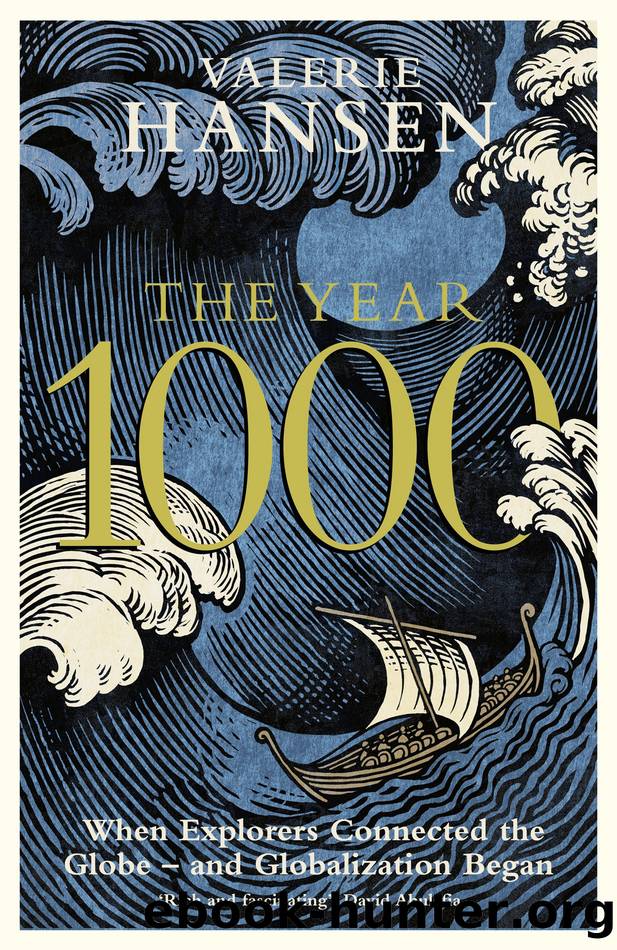The Year 1000 by Valerie Hansen

Author:Valerie Hansen [Hansen, Valerie]
Language: eng
Format: epub
ISBN: 9780241984178
Publisher: Penguin Books Ltd
Published: 2020-03-04T00:00:00+00:00
CHAPTER SEVEN
Surprising Journeys
Mapmakers divide the waters between Africa and Japan into different seas—the Arabian Sea, the Indian Ocean, the Bay of Bengal, the South China Sea, the East China Sea, and the Pacific Ocean—but in actuality these formed one continuous waterway, which mariners traveled along by hugging the coastline.
Their early voyages took advantage of the monsoon winds to explore and to transport goods from the Arabian Peninsula to India and later to China.1 The winds determine the best times to travel in the Indian Ocean. In winter, the Eurasian landmass cools down, sending dry air over the oceans, and in summer, when Eurasia heats up, it creates a vacuum that sucks in water-laden air from over the oceans, causing the heavy rains so essential to agriculture.2 By 200 BC, sailors in the Bay of Bengal understood the annual rhythms of the monsoon well enough to ride its winds between India and Southeast Asia, and by AD 1000, they were certainly voyaging across the open ocean.3
The main items traded in the region were locally grown fragrant woods, plants, and spices, all of which qualify as “aromatics,” a convenient catchall term for these different products. The Spice Islands, or the Moluccas of modern Indonesia, are justly famous for being the home of multiple spices including cloves and nutmeg. In a world in which few people bathed and most meals were simple, these aromatics had enormous appeal. Within the region metals such as gold, tin, and silver were also traded, and cotton textiles were extremely popular because they were so well suited to the climate.
The long-distance slave trade in the Indian Ocean wasn’t as large as in the Islamic world, probably because most societies were able to source slaves and other types of laborers locally. Moreover, the societies around the Indian Ocean didn’t encourage the freeing of slaves as did contemporary societies in the Islamic world. As a result, they did not have to replenish their slave populations.
The European voyages across these oceans around 1500 weren’t the first chapter of globalization for the region. One thousand years earlier local mariners were already regularly traversing the sea routes later “discovered” by da Gama and Magellan. Nor did European mariners introduce long-distance commerce, which was well established at the time of their arrival. What the Europeans wanted to do, and eventually did do, was cut out the middlemen and avoid paying duties to rulers. In Africa, the Europeans gained direct access to the sources of gold and slaves, and in the Spice Islands they found out how to purchase spices, woods, and other aromatics without going through middlemen.
The most surprising journeys around the year 1000 took place between the Malay Peninsula and Madagascar on the east coast of Africa some 4,000 miles (6,500 km) away (just under the 4,400 miles, or 7,000 km, of Columbus’s first voyage). Although Madagascar is only some 250 miles (400 km) off Africa’s east coast, the language of the islands, Malagasy, is related to Malayic languages and not—as you’d expect—to the Bantu family of languages predominant in Africa and along the East African coast.
Download
This site does not store any files on its server. We only index and link to content provided by other sites. Please contact the content providers to delete copyright contents if any and email us, we'll remove relevant links or contents immediately.
| Civilization & Culture | Expeditions & Discoveries |
| Jewish | Maritime History & Piracy |
| Religious | Slavery & Emancipation |
| Women in History |
Cecilia; Or, Memoirs of an Heiress — Volume 1 by Fanny Burney(31341)
Cecilia; Or, Memoirs of an Heiress — Volume 3 by Fanny Burney(30938)
Cecilia; Or, Memoirs of an Heiress — Volume 2 by Fanny Burney(30894)
The Secret History by Donna Tartt(16643)
Sapiens: A Brief History of Humankind by Yuval Noah Harari(13067)
Leonardo da Vinci by Walter Isaacson(11912)
The Radium Girls by Kate Moore(10914)
Sapiens by Yuval Noah Harari(4546)
The Wind in My Hair by Masih Alinejad(4427)
How Democracies Die by Steven Levitsky & Daniel Ziblatt(4407)
Homo Deus: A Brief History of Tomorrow by Yuval Noah Harari(4287)
Endurance: Shackleton's Incredible Voyage by Alfred Lansing(3852)
The Silk Roads by Peter Frankopan(3769)
Man's Search for Meaning by Viktor Frankl(3644)
Millionaire: The Philanderer, Gambler, and Duelist Who Invented Modern Finance by Janet Gleeson(3574)
The Rape of Nanking by Iris Chang(3522)
Hitler in Los Angeles by Steven J. Ross(3443)
The Motorcycle Diaries by Ernesto Che Guevara(3340)
Joan of Arc by Mary Gordon(3262)
